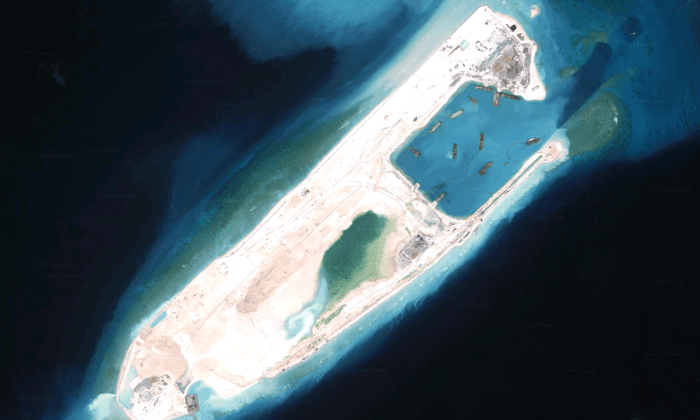This article was originally dispatched as part of Epoch Times’ China email newsletters. Subscribe to the newsletters by filling your email in the “China D-brief” box under this article.
China’s designs on the South China Sea appear to be going from the strange to the bizarre.
Since December 2013, the Chinese Communist Party (CCP) has created more than 2,900 acres of land in the Spratlys Islands in the South China Sea.
It does this by using ships to pump sand and mud from the ocean floor to build new islands. Then, it builds runways, military barracks, and surveillance equipment atop them.
A DOD report released last Thursday explains that the People’s Liberation Army Navy “has now reclaimed 17 times more land in 20 months than the other claimants combined over the past 40 years,” and close to 95 percent of claimed territory in the Spratly Islands is now under its flag.
This, understandably, began ruffling feathers both in the region and internationally.
With international pressure clearly building, China on Aug. 5 promised it would stop. But not before going all out on a final island building spree: according to the same Pentagon report, 900 of the 2,900 new acres of territory were created in a single month between May and June.
Those who have been following the issue may remember what else happened between May and June. The United States upped its efforts to work with countries neighboring China, and on May 30, at the Shangri-La security dialogue, Secretary Carter announced the Southeast Asia Maritime Security Initiative to address maritime challenges in the region.
The Chinese regime was getting pushed into a corner. So it promised it would stop, and Reuters published a widely reproduced article on Aug. 5, with the headline, “China says has stopped reclamation work in South China Sea.”
But anyone who thought China was really slowing down was sorely misled. “This was taken as a change in policy by news outlets in the United States, when in reality it was not at all,” said Mira Rapp-Hooper, director of the Asia Maritime Transparency Initiative at the Center for Strategic & International Studies, in a previous interview with Epoch Times.
“It means they’re moving onto Phase Two, which means the construction of facilities and capabilities on these islands.”
Additionally, the strategy is getting more creative: floating islands.
The PLAN is now building “very large floating structures” (it has an acronym, “VLFS”), first reported on Aug. 9 by online naval defense industry magazine, Navy Recognition:
“The first identified VLFS is kilometers long and made up of floating modules connected together. It can be assembled as required and used as a floating pier, logistics base and airport. A large floating island or airport or sea base can be achieved by linking a several floating platforms, which is very valuable for military and civilian use, said an expert interviewed by Shenzhen TV.”
The story on the VLF was reported by Business Insider on Aug. 10 (though for some reason it was deleted.)
Navy Recognition included a concept video showing how the structures would function. Enjoy.


![[LIVE 4/26 at 10:30AM ET] New Push Started for Global Digital Currencies](/_next/image?url=https%3A%2F%2Fimg.theepochtimes.com%2Fassets%2Fuploads%2F2024%2F04%2F19%2Fid5633115-0426-1080x720.jpg&w=1200&q=75)


